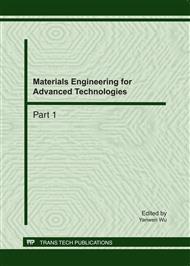p.235
p.238
p.242
p.246
p.250
p.256
p.261
p.266
p.272
Identification of Biomedical Constituents of 450 °C Pyrolyzate from Benzene/Ethanol Extractives of Moso Bamboo Root
Abstract:
The bamboo resource is very abundant in China, and both species and yield of bamboo are the first in the world. In the countryside of China, farmers often used the extractives of bamboo root to cure some special diseases; however, the biomedical constituents of extractives of bamboo root are still not completely explained. Therefore, 450 °C pyrolysis- GC/MS technology was used to identify the top value-added biomedical constituents of root-based benzene/ethanol extractives from the richest bamboo species “Moso bamboo”. After treatment of benzene/ethanol extraction, the extractives obtained was fully pyrolyzed at 450 °C in He atmosphere, and then the 450 °C pyrolyzate obtained was analyzed by online-linked GC/MS. Relative content of each component was determined by area normalization. 59 chemical constituents representing 97.62% were identified from 64 peaks. The analytical result showed that the 450 °C pyrolyzate of benzene/ethanol extractives from Moso bamboo root is abundant in biomedical constituents, and also contains other bioactive components, which can be used as top value-added materials of high-grade cosmetic, food, spice, and chemical. The result will be useful to expedite biomedical development of root extractives, and to provide further scientific foundation for its top value-added application of bamboo resources.
Info:
Periodical:
Pages:
250-255
Citation:
Online since:
June 2011
Authors:
Price:
Сopyright:
© 2011 Trans Tech Publications Ltd. All Rights Reserved
Share:
Citation:


